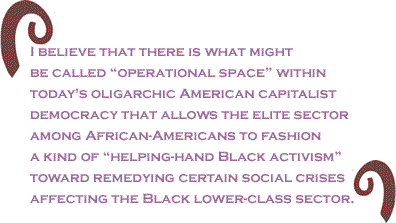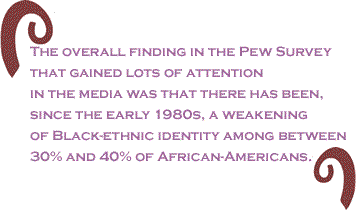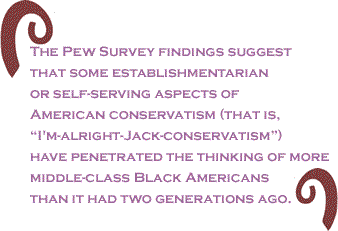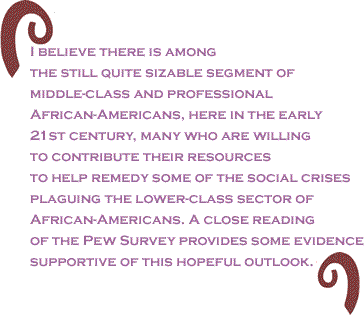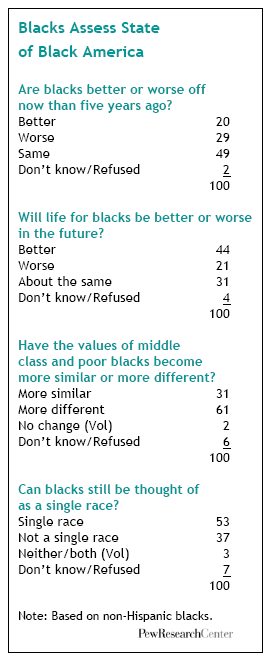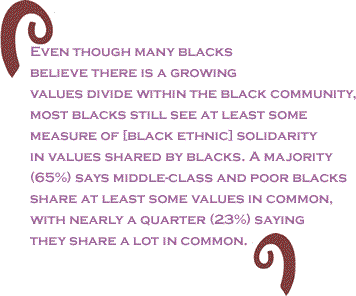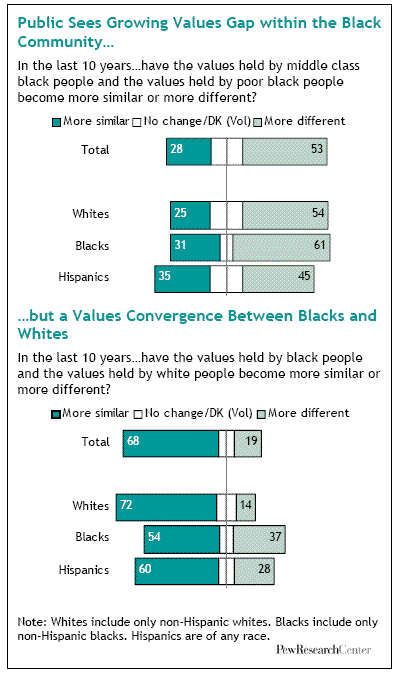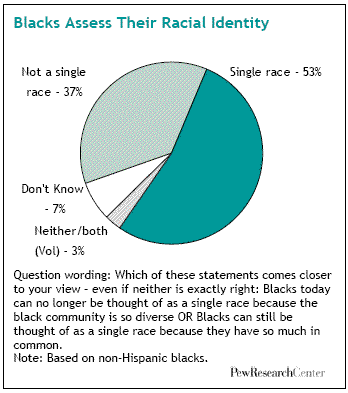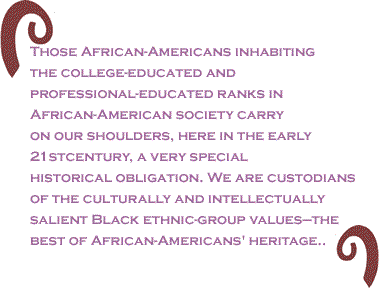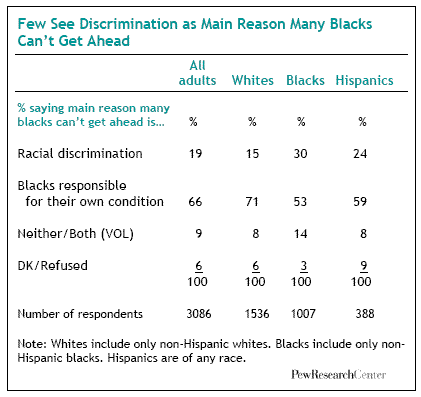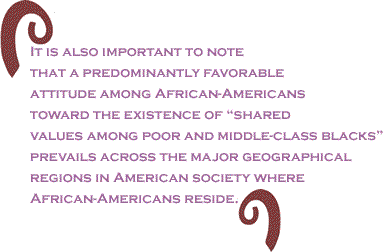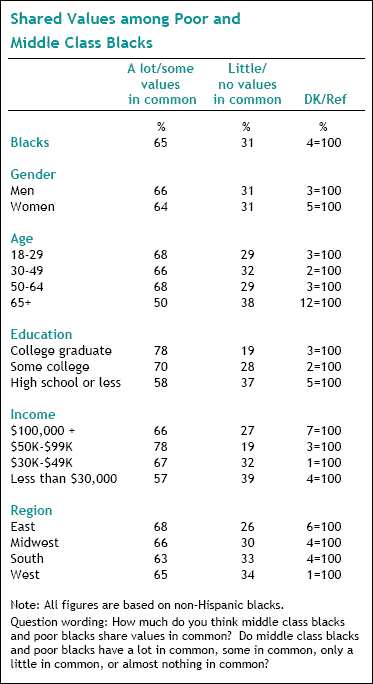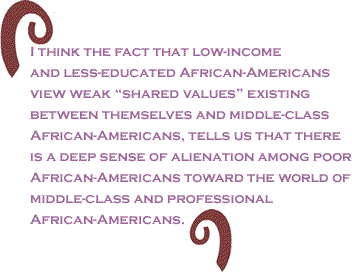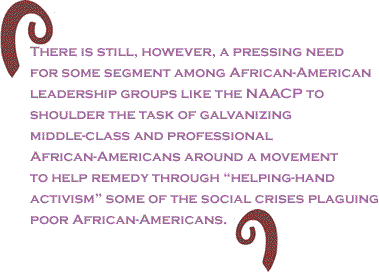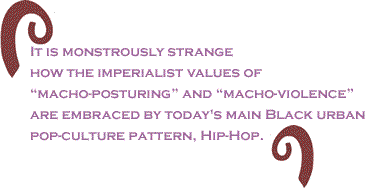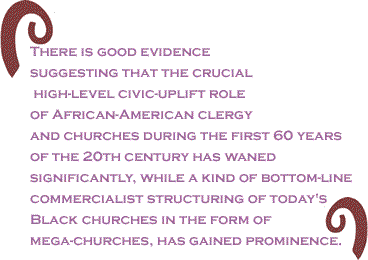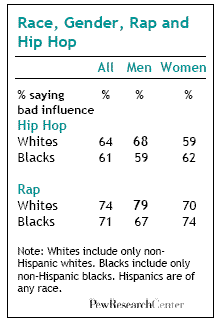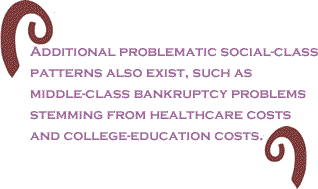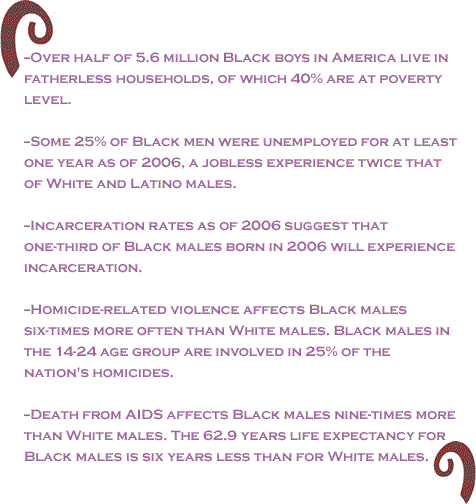
|
|||||||||||||||||||||
 |
|||||||||||||||||||||
|
||||||||||
|
||||||||||
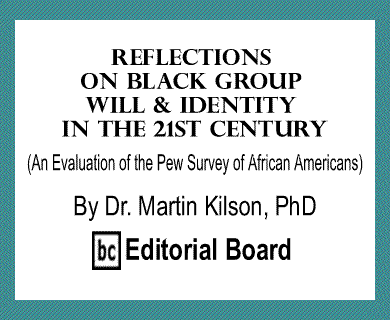 |
||||||||||
 |
||||||||||
The current issue is always free to everyone If
you need the access available to a |
||||||||||
 |
||||||||||
INTRODUCTORY
The issue of the character of African-American group will and identity here in the early years of the 21st century has recently received major attention through two research studies produced by the Pew Charitable Trusts and the related Pew Research Center, located in Philadelphia and Washington, D.C. The two new Pew studies are of fundamental importance to African-Americans, so I thought I'd write an essay for BlackCommentator.com containing evaluative reflections on some implications of the Pew studies for African-Americans today.
Over the past 20 years I've been working on a two-volume study of the evolution of the African-American professional stratum or intelligentsia during the 20th century into the 21st century. I have now completed the first volume of this study—titled The Making of Black Intellectuals: Studies on the African-American Intelligentsia—and I am working full-time on the second volume—titled The Transformation of the African-American Intelligentsia, 1900-2008. Any serious probe of the development of the 20th century African-American professional class (teachers, scholars, lawyers, doctors, dentists, nurses, accountants, financial analysts, engineers, scientists, artists, writers, journalists, etc.) under the onerous and dispiriting conditions defined by the American White supremacist juggernaut, must first arrive at an analytical understanding of the character of what I call “African-American group will and identity”.
By which I mean, an understanding of what facilitates an individual “viable self-efficacy” and a general “viable ethnic-group efficacy” among African-American citizens whose daily lives throughout most of the 20th century were shaped and harassed by the cruel exigencies of America's White supremacist civilization, by its norms and operational agencies. The origin of the core culture-axial attributes of African-Americans' make up as a people, extends back-in-time to the earliest African-American intelligentsia personalities. Back-in-time to leadership personalities such as pre-Civil War era abolitionist figures like William Cooper Nell (a Boston abolitionist writer), Frederick Douglass (the brilliant and courageous abolitionist thinker, writer, and activist), and abolitionist clergymen like Rev. J.W.C. Pennington and Rev. John Sella Martin; to Emancipation Era leaders like AME Bishop Henry McNeal Turner, AME Bishop Daniel Alexander Payne, physician and intellectual Martin Delaney, and Alexander Crummell and John Wesley Cromwell (founders of the American Negro Academy in 1897); and to early 20th century intelligentsia figures like W.E.B. DuBois, Monroe Trotter, Archibald Grimke, and Reverdy Ransom (all foundation members of the Niagara Movement in 1905).
If just one African-American text is singled-out as quintessentially representing the culture-axial dynamics that define “a viable Black self-efficacy” and “viable Black ethnic-group efficacy”, I would vote unhesitatingly for W.E.B. DuBois' masterful 1903 text The Souls of Black Folk. It was during my college years at one of the earliest colleges founded for African-American youth—Lincoln University in Pennsylvania—that I experienced Black people's culture-axial dynamics which helped me in defining for myself an understanding of what might be called the “obligation-and-responsibility issue” as it related to one's membership in the Black American professional stratum. When I entered Lincoln University in the fall of 1949, over 90% of African-American youth gaining a college education were attending Black colleges like Lincoln University, Hampton Institute, Fisk University, Howard University, Tuskegee Institute, Morehouse College, Spellman College, Virginia Union University, etc. Unlike today, most college-going Black Americans were not attending the Pennsylvania State University (fewer than 20 Blacks attended Penn State in 1949) or other major public universities in the country where most White students gained education, let alone the select private institutions of higher education like the University of Pennsylvania, Bucknell University, Princeton University, , Yale University, Dartmouth College, Brown University, Harvard University, University of Chicago, etc.
Accordingly, attendance at Lincoln University for me and the other nearly 600 students there afforded us a culturally and intellectually unique opportunity if we were inclined to seize it. Namely, the opportunity to commence a multi-faceted intellectual (academic), cultural, and ideological fashioning for ourselves of a “viable Black self-efficacy” and thereby fashioning also the ingredients or connective-cultural-tissues of a “viable Black ethnic-group efficacy.” What were then called the Negro colleges attended by my college-going age cohort of African-American youth over a half-century ago were indispensable for this development of a “viable Black self- efficacy”. This development for any particular Black college-educated African-American from the World War I years into the 1960s, was subsequently translated or advanced into a “viable Black ethnic-group efficacy” by numerous professional organizations and activist civic and voluntary associations in the broader African-American society. Such as organizations for Black lawyers (e.g., the National Bar Association), doctors, dentists, teachers, academics; activist civic and political associations like the National Council of Negro Women and the NAACP; civic activist religious denominations like the African Methodist Episcopal Church; and activist voluntary associations like Greek Letter sororities and fraternities, the Negro Elks, Prince Hall Masons, the Knights of Pythias, etc.
Fortunately for me, the Lincoln University that I entered in 1949 had on its faculty and in its administration a cadre of African-American professionals who had shaped their intellectual identity along the lines of what might be called the “DuBoisian civil rights activism paradigm.” This was the Black intelligentsia outlook which favored challenging America's racist patterns, as contrasted with Booker T. Washington's accommodationism orientation which acquiesced in America's racist patterns on the dubious assumption that they would self-correct unchallenged somewhere in the future.
Thanks to my intellectual mentors at Lincoln University such as Horace Mann Bond (president of Lincoln University who also taught a course on “The Negro in the Old World and New World”), John Aubrey Davis (political science scholar), Joseph Newton Hill (English and Drama Studies scholar who was Dean of College and directed Lincoln's Debating Team), Henry Cornwell (psychology scholar), James Bonner McRae (sociology of education scholar who was Dean of Students), and Laurence Foster (anthropology scholar), the DuBoisian civil rights activism leadership perspective was the orientational guidepost by which I chiseled out my understanding of the obligation-and-responsibility that college-educated individuals owed the larger African-American society. The core attribute of the DuBoisian view of the obligation-and-responsibility issue as it related to the evolving 20th century African-American professional class (the “Talented Tenth” as DuBois dubbed it) might be characterized as a “Black-ethnic commitment outlook.” This was essentially a two-fold ethnic-group commitment on the part of that evolving 20th century college-educated African-American sector:
1) A commitment to challenge the American White supremacist edifice.
2) A commitment to assist
the advancement of modern human rights
W.E.B. DuBois arrived at this conception of the “obligation-and-responsibility issue”—as it related to the emergent African-American professional class' relationship to the working-class and poor Black masses—through his fierce ideological combat with the dominant Booker T. Washington accommodationism leadership outlook that prevailed during the 1890s into the first two decades of the 20th century. Writing in 1903 in his great book The Souls of Black Folk , the young W.E.B. DuBois (just seven years after gaining his PhD degree at Harvard University) fashioned the ideological guidepost for his future leadership career. Referring to his own circle of Black professional friends as “the other class of Negroes who cannot agree with Mr. Booker T. Washington...,” DuBois boldly expressed the progressive principles of a Black leadership outlook that challenged Washington's accommodationism perspective. DuBois, while rather magnanimously remarking that his own circle “of men in black leadership honor Mr. Booker T. Washington for his attitude of conciliation toward the white South...,” delineated the indispensable principles of a progressive Black intelligentsia nexus with the Negro masses. This nexus, DuBois proclaimed, was premised above all on fidelity with Black people's honor—fidelity with the moral rightness of their quest to have American democracy redress the horrendous injury to Black people by American slavocracy and Jim Crow practices.
Or as W.E.B. DuBois put this issue in The Souls of Black Folk: “They [DuBois' network] insist that the way to truth and right lies in straightforward honesty, not in indiscriminate flattery...in remembering that only a firm adherence to their higher ideals and aspirations will ever keep those ideals within the realm of possibility.” He then elaborated this anti-Booker T. Washington proposition as follows: They [DuBois' professional circle] are absolutely certain that the way for a people to gain their reasonable rights is not by voluntarily throwing them away and insisting that they do not want them; that the way for a people to gain respect is not by continually belittling and ridiculing themselves; that, on the contrary, Negroes must insist continually, in season and out of season, that voting is necessary to modern manhood, that color discrimination is barbarism, and that black boys need education as well as white boys. (The Souls of Black Folk (Chicago: McClurg Co., 1903) pp. 53-55) Building upon these indispensable core principles of a progressive Black intelligentsia/Black masses nexus, the young W.E.B. DuBois forcefully expressed what became, within two generations, the dominant vision of the “obligation-and-responsibility issue” among the evolving 20th century African-American professional class or intelligentsia. As DuBois expressed this vision in The Souls of Black Folk: In failing thus to state plainly and unequivocally the legitimate demands of their people...the thinking classes of American Negroes would shirk a heavy responsibility—a responsibility to themselves, a responsibility to the darker races of men whose future depends so largely on this American [Negro] experiment.... It is wrong...to aid and abet a national crime simply because it is unpopular not to do so. (The Souls of Black Folk (1903), p. 55) It
was a momentous American historical context that eventually
defined W.E.B. DuBois' vivid formulation of the indispensable
core principles of a progressive Black intelligentsia/Black
masses nexus—namely, the historical context of “Reunion and
Reconciliation.” Which is to say, the context of the cynical
post-Reconstruction Era
It was, then, precisely the need for the early evolving 20th century African-American leadership to challenge the underlying anti-Negro foundations of “Reunion and Reconciliation”, that inspired the young W.E.B. DuBois' fervent quest to forge a progressive Black intelligentsia/Black masses nexus, and thus thereby forge also what I characterize above as a “viable Black ethnic-group efficacy.” DuBois formulated the ideas that informed this fervent quest as follows: ...If ...reconciliation [with Southern racism] is to be marked by the industrial slavery and civic death of black men, with permanent legislation into a position of inferiority, then those black men, if they are really men, are called upon by every consideration of patriotism and loyalty to oppose such a course by all civilized methods, even though such opposition involves disagreement with Mr. Booker T. Washington. We have no right to sit silently by while the inevitable seeds are sown for a harvest of disaster to our children....
In his seminal book Democracy Matters: Winning the Fight against Imperialism (2004), the Princeton University philosophy scholar Cornel West provides a key insight into the young W.E.B. DuBois' thinking in regard to the Black intelligentsia/Black masses nexus as presented in The Souls of Black Folk. In delineating the principles defining this nexus, DuBois, says Cornel West, aided in “lift[ing] the veil over the invisibility of the black individuals, community, and society denied by white supremacist America.” In so doing says Professor West, the young DuBois was functioning as one of early 20th century America's “Emersonian democratic intellectuals.” By this expression, Professor West is referring to Ralph Waldo Emerson's particular view of a progressive democratic intellectual as delineated in Emerson's essay titled “The American Scholar” (1837) and his essay titled “Self-Reliance” (1841). Cornel West informs us that “For Emerson, to be a democratic individual is to speak out on uncomfortable truths....” And Emerson himself did precisely that, fashioning for himself a humanist-activism worldview through ...his famous efforts to oppose the 'removal' of the Cherokee from Georgia in 1835 and to contest the Fugitive Slave Act of 1850. In his public praise of John Brown after the raid on Harpers Ferry and his celebration of the emancipation of slaves in the West Indies (when he shared the platform with the great Frederick Douglass).... p.74 It was, then, the young W.E.B. DuBois' profound fidelity to Black people's freedom quest (their citizenship and human rights fought for in the bloody Civil War and guaranteed in the 13th, 14th, and 15th Amendments to the U.S. Constitution) that led him to reject Booker T. Washington's accommodationism approach to how the evolving 20th century African-American professional class or intelligentsia should define its relationship with the great mass of working-class and poor African-Americans. Starting first with his Black-people empathetic 1903 essays in The Souls of Black Folk, then in 1905 with the founding with Monroe Trotter and others of the Niagara Movement, and further in 1909 with a role in founding the NAACP, W.E.B. DuBois helped to lay the civil rights activism foundations upon which millions of African-American individuals could endeavor to fashion both a “viable Black self-efficacy” and through this a “viable Black ethnic-group efficacy.”
PEW SURVEY OF STATE OF BLACK AMERICA: (I) SHARED VALUES ISSUE
Returning this discussion to the time frame of our contemporary era, we must ask and then attempt to answer the question: “What are the intrinsic and operational conditions of the notion of a “viable Black ethnic-group efficacy” here in the first decade of the 21st century?”
The relevance of this question to the state of affairs prevailing among African-Americans today is, I think, governed significantly by the multi-layered social crises that surround the life-chances of the weak working-class and poor sector of African-Americans, a sector comprising some 40% of Blacks America. The major social crises can be listed serially as follows:
--Crisis of poverty and related crisis of joblessness.
--Fragile family single-parent households.
--High teenage pregnancies and thus high unwed motherhood/fatherhood.
--Macho-violence and related Hip-Hop influenced macho-male “gansta-culture.”
--High Black youth homicide spawned by macho-male violence patterns.
--Social crises stemming from high incarceration of Black males,which incarceration is linked to America's racist-skewed criminal justice practices.
--High dropout rates in schools and thus poor education achievement among working-class Black youth.
I mentioned the crisis of poor education achievement last for a good reason. Because I believe it is a contemporary crisis-area facing the lower-class sector of African-Americans that middle-class and professional-class African-Americans with a “helping-hand Black activism” orientation can readily give attention to. That the education achievement crisis among working-class Black youth requires this attention was pointed out recently by the education scholar, Dr. John Merrow, in a lecture at the Harvard School of Education in November 2007. He commented on the education crisis facing African-American and Latino-American working-class youth as follows: The achievement gap in American K-12 schools is well-documented, and is characterized by racial and class differences. By the end of fourth grade, black, Latino, and poor students of all races are two years behind their wealthier (and mostly white) peers in reading and math scores. By 12th grade, that gap has widened by four years. By age 17, only one in 50 black and Latino students can read and comprehend something like the science section of a newspaper. For whites, the comparable rate is one in 12. (Harvard Gazette (November 8, 2007). Now when the kind of social crises facing the working-class and poor sector of African-Americans involve, say, “crises of poverty” and “crises of joblessness”, I believe that anything approximating an aggregate systemic response toward remedying those kind of social crises will require programs fashioned by federal public policy, on the one hand, in concert with enlightened economic policies on the part of national economy institutions, on the other hand.
However, in that time interim between now and when this optimum set of policy programs obtains—most likely a long-run interim I suspect—I believe that there is what might be called “operational space” within today's oligarchic American capitalist democracy that allows the elite sector among African-Americans to fashion a kind of “helping-hand Black activism” toward remedying certain social crises affecting the Black lower-class sector. I have in mind especially social crises like the “poor education achievement crisis”, “teenage pregnancies and unwed motherhood/fatherhood crises”, “fragile single-parent family crisis”, the “Hip-Hop influenced macho-male gansta-culture crisis”, “Black youth homicide crisis”, and perhaps some other social crises as well.
Whatever kinds of Black social crises that today's middle-class and professional-class African-Americans might galvanize themselves to help remedy, any such “helping-hand Black activism” revolves initially around the “Black group will issue”. The recent Pew Research Center study titled Blacks See Growing Values Gap between Poor and Middle Class (Philadelphia: Pew Research Center, November 2007 (Click here to view the complete report in PDF format.) – referred to as “Pew Survey” hereafter—contains information which suggests that the “Black group will issue” is more complicated today than it was, say, two generations ago. Below is a Pew Survey chart presenting an overview of its findings:
Put another way, the Pew Survey findings require liberal and progressive elements among middle-class and professional African-Americans (elements with which I classify myself) to ask ourselves whether under today's conditions of a two-tier Black American class system, is the 20th century DuBoisian idea of a “viable Black ethnic-group efficacy ” still valid and operational. A two-tier Black class system means that there is a larger and more affluent middle-class and professional sector, on the one hand (some 60% of African-Americans) but on the other hand a still sizable weak working-class and poor sector (some 40% of African-Americans). Now I believe that although there is today a two-tier Black American class system, the DuBoisian idea of “Black ethnic-group efficacy” remains valid and operational. But let's see how the new Pew Survey findings complicate our understanding of the “Black group will issue” as it affects the need for today's Black elite sector to help remedy Black lower-class crises.
Before analyzing some aspects of Pew Survey, however, we might gain a sharper understanding of the issue of “Black group will” toward helping remedy Black lower-class crises by reference to an interview that the Princeton University philosophy scholar Cornel West had with the editors of Black Enterprise Magazine in 2005. In that interview—published in Black Enterprise Magazine (February 2005)—Professor West was asked what he thought of the overall education situation as it related to African-Americans. He replied as follows: I think it's magnificent for [the] black middle class and above, but it's a national disgrace for the black working poor and the very poor. There is a class difference that we have to acknowledge. Sure, for my son any my daughter, it's cool.... I have some cash. You know what I mean? But I have cousins and I have friends and relatives who are not as blessed as I am. Here Cornel West gives us a special insight into the current “Black group will issue”.
One aspect of the special insight he provides us relates to the existence of Professor West's relatives who inhabit working-class ranks in society and thus lack access to the favorable side of educational opportunity in American society. It happens that a sizable proportion of todays' middle-class and professional African-Americans share with Cornel West the existence of relatives still inhabiting working-class and poor ranks in American society, so this type of “cross-class family ties” might make such middle-class African-Americans favorably disposed toward helping to remedy Black social crises.
Another aspect of Cornel West's interview response that we should note is that since he is publicly identified with the liberal and progressive side of the American political spectrum, we can infer from this that he is favorably disposed toward a “helping-hand Black activism” endeavor to help remedy social crises plaguing lower-class African-Americans. Put another way, in the individual case of Professor Cornel West the “Black group will issue” is not a problem because his liberal ideological make up keeps him sympathetic toward a “helping-hand Black activism” orientation.
Now what the recent Pew Survey findings suggest is that when the “Black group will issue” is viewed in terms of a wider political spectrum and social-class spectrum among African-Americans, the character of the “Black group will issue” becomes more complicated than in the instance of a progressive-oriented African-American professional like Cornel West.
According to the 2007 Pew Survey of Black attitudes, there has been since 1980 an important degree of attitude differentiation among African-Americans in regard to what it calls “Black Shared Values”.
Pew researchers asked 1,007 Blacks about the degree they “shared values with other African-Americans”, and also whether they thought of African-Americans “as a single race because the black community today is so diverse.” The overall finding in the Pew Survey that gained lots of attention in the media was that there has been, since the early 1980s, a weakening of Black-ethnic identity among between 30% and 40% of African-Americans. The Pew study reported these findings as follows:
1) “By a ratio of two-to-one [61% to 30%] blacks say that the values of poor and middle class blacks have grown more dissimilar over the past decade.” (Pew Survey, p. 3 chart)
2) “A sizable minority of African Americans (37%) agrees with the idea that blacks today can no longer be thought of as a single race because the black community today is so diverse.” (Pew Survey, p. 2 chart)
Now on one analytical level, these findings suggest that galvanizing a viable quantum of “Black group will” for the task of helping to remedy lower-class Blacks' social crises might be a difficult undertaking in the years ahead. For example, the Pew Survey findings suggest that some establishmentarian or self-serving aspects of American conservatism (that is, “I'm-alright-Jack-conservatism”) have penetrated the thinking of more middle-class Black Americans than it had two generations ago.
This is suggested, for example, by a Pew Survey finding that “A narrow majority of blacks (53%) believe that blacks who have not gotten ahead in life are mainly responsible for their own situation.” This “I'm-alright-Jack-conservatism attitude” among a half of Black Americans is closely connected to the above-mentioned attitude among 60% of Black Americans that “the values of poor and middle-class blacks have grown more dissimilar over the past decade.” (See Pew Survey Chart)
What
this “I'm-alright-Jack-conservatism
attitude” suggests is that some middle-class African-Americans
in particular have become comfortable (too comfortable from
my perspective) in their new status in American society, satisfied
that the viciously dispiriting, pariahizing, and threatening
aspects of the American racist order have dissipated or even
disappeared for many them. Just think back a half-century ago (the period my generation of professional African-Americans was attending professional schools) when Jim Crow practices polluted every corner of social, economic, and political life in American society. Thus American society has certainly changed for the better, for here in the early 21st century many more African-Americans than ever before feel mentally free to view their present and future possibilities –and that of their children - as dependent upon their own capabilities, no longer threatened and pariahized by American racism. This enables them also to embrace “I'm-alright-Jack-conservatism attitudes”. And some “I'm-alright-Jack-conservatism-oriented” African-Americans have become Republican Party voters, though still amounting to only 10% of Black voters.
Now in light of the fact that perhaps some African-Americans no longer consider American racist patterns as a threat to their existence here in the early 21st century, it is important to remember that this was, after all, a major goal of the long and courageous struggle of the Civil Rights Movement - a goal of the Niagara Movement, the NAACP, the National Council of Negro Women, the National Urban League, the National Negro Congress, CORE, the SCLC, etc. Accordingly, on one hand, most African-Americans welcome this development. On the other hand, however, it remains an obligation for those of us on the liberal and progressive side of the American political spectrum to continue a commitment to the early 20th century DuBoisian ideas that defined the progressive side of civil rights activism. Namely, that there is no genuine equalitarian political and social attainment for Black folk until the socially and economically weakest sector of African-Americans (today's weak working-class and poor African-Americans—some 40% of Black America) can mount the equalitarian steps on America's social mobility ladder.
PEW SURVEY OF STATE OF BLACK AMERICA: (II) IDEOLOGICAL ISSUES
Accordingly, the Pew Survey produced another set of findings which indicate that, while a kind of “I'm-alright-Jack-conservatism” outlook has increased among African-Americans in the post-Civil Rights Movement period, this new Black establishmentarian pattern is contingent. Which is to say, there is still a very sizable segment among middle-class and professional-class African-Americans who remain committed to what I call the DuBoisian ideas regarding civil rights activism during most of the 20th century. It is, I believe, among the still quite sizable segment of middle-class and professional African-Americans, here in the early 21st century, many who are willing to contribute their resources to help remedy some of the social crises plaguing the lower-class sector of African-Americans. A close reading of the Pew Survey provides some evidence supportive of this hopeful outlook.
The hopeful aspects of the 2007 Pew Survey findings might be called “countervailing findings”. I call them “countervailing findings” because they suggest that , although an “I'm-alright-Jack-conservatism attitude” has gained supporters among African-Americans today, there is nevertheless and happily a sizable segment of middle-class and professional African-Americans who remain committed to the DuBoisian 20th century progressive attitude toward the “Black group will issue”.
One important “countervailing-finding” in the 2007 Pew Survey is a response to the finding that 37% of Blacks in the Pew Survey “agree with the idea that blacks today can no longer be thought of as a single race because the black community today is so diverse.” In response to this, a “countervailing-finding” in the Pew Survey stated: “However, a majority of 53% disagrees, endorsing instead the view that 'blacks can still be thought of as a single race because they have so much in common'.” (Pew Survey, p. 24). (Emphasis Added).
A second important “countervailing-finding” in the Pew Survey is a response to the finding of a two-to-one belief among African-Americans (61% to 31%) that “the values of poor and middle-class blacks have grown more dissimilar over the past decade.” The countervailing-finding” in regard to this so-called “values gap” is that a sizable majority of African-Americans nevertheless believe in the existence of “generalized shared Black ethnic values,” so to speak.
Data shown in TABLE I details this particular “countervailing-finding”. In the Pew Survey this finding is described as follows: Even though many blacks believe there is a growing values divide within the black community, most blacks still see at least some measure of [black ethnic] solidarity in values shared by blacks. A majority (65%) says middle-class and poor blacks share at least some values in common, with nearly a quarter (23%) saying they share a lot in common. (Pew Survey, p. 23 chart) TABLE 1
A third important “countervailing-finding” relates to whether or not political affiliation in regard to liberalism or conservatism in American society influences African-American attitudes toward the so-called “values gap” among Black Americans. In general, the Pew Survey found that African-Americans who identify themselves on the liberal side of the political spectrum are more inclined to proclaim that “shared values” exist among middle-class and poor African-Americans. As the Pew Survey reports this matter: There are also political differences on this [“shared values”] question. Black liberal Democrats are 15 percentage points more likely than political independents (74% compared with 59%) to say middle class and poor blacks have values in common. (Pew Survey, p. 23) A fourth important “countervailing-finding” in the Pew Survey informs us that although there is an overall 61% of African-Americans who say “values of poor and middle-class blacks have grown more dissimilar over the past decade”, continued belief in “shared values among poor and middle-class blacks” is strongest among the best educated sector of African-Americans.
This “countervailing-finding” is underscored by data shown in TABLE 1, which show that belief in “shared values among poor and middle-class blacks” is proclaimed by 70% of African-Americans “with some college education” and this belief is proclaimed by 78% of“college graduates” among African-Americans.
Put another way, those African-Americans inhabiting the college-educated and professional-educated ranks in African-American society carry on our shoulders, here in the early 21stcentury, a very special historical obligation. We are custodians of the culturally and intellectually salient Black ethnic-group values—the best of African-Americans' heritage , if you will.
It is also important to note that a predominantly favorable attitude among African-Americans toward the existence of “shared values among poor and middle-class blacks” prevails across the major geographical regions in American society where African-Americans reside. Thus (1) in the South where the largest segment of African-Americans now reside, 63% say “a lot or some shared values”; (2) in the West where the smallest segment of African-Americans reside, 65% say “a lot or some shared values”; and (3) in the East and Midwest where the second largest segment of African-Americans reside, 66% say “a lot or some shared values”.
Furthermore, these clearly positive attitudes toward the existence of “shared values” among African-Americans that have been sustained across all geographical regions, were reinforced by a New America Media Survey in September 2007 (published in New York Times (December 13, 2007))which found that 67% of African-Americans say “most friends are of the same race or ethnicity.” This 67% high level of ethnic friendship-pattern among African-Americans compared with a similarly high ethnic friendship-pattern of 73% reported by Latino-Americans. By the way, the New America Media Survey didn't report the ethnic friendship-pattern level for White American groups but other studies of this social dynamic in American society place the White ethnic friendship-pattern around 60%. The main point to make here is that, while there has certainly been a growth in the differentiation of ethnic group values among African-Americans (changing “shared values” as the Pew Survey puts it) during the post-Civil Rights Movement years, there remains still a strong expression of Black ethnic group values among college-educated middle-class and professional-class African-Americans, this being very good news I think.
Accordingly, in light of the foregoing Pew Survey findings that between 65% and 78% of college-educated African-Americans entertain positive attitudes toward the existence of “shared values among poor and middle-class blacks”, there is very good reason to be hopeful that it is possible to mobilize the Black elite sector to galvanize its resources to help remedy social crises among our weak working-class and poor African-American citizens. As I remarked above, I gained a serious understanding of a “viable Black ethnic-group efficacy” over a half-century ago as a student at Lincoln University, on the basis of which I fashioned an intellectual commitment to the DuBoisian progressive civil rights activism perspective. And I still believe that a combination of these two African-American ideological orientations can motivate enlightened persons among middle-class and professional African-Americans, here in the early 21st century, to galvanize Black elite capabilities to help remedy social crises among lower-class African-Americans.
PEW SURVEY OF STATE OF BLACK AMERICA: (III) SOCIAL MOBILITY ISSUES
One last aspect of the Pew Survey of African-American attitudes requires mentioning. That aspect relates to the somewhat strange fact that nearly 40% of African-Americans who have no post-high school education or less believe that “middle class and poor blacks have few or no shared values [whereas]...among the college educated, just 19% say this.” (Pew Survey, p. 23 - TABLE 1). It should also be noted that 39% of African-Americans earning less than $30,000 annually believe that “middle-class and poor blacks have few or no shared values.”
I think the fact that low-income and less-educated African-Americans view weak “shared values” existing between themselves and middle-class African-Americans, tells us that there is a deep sense of alienation among poor African-Americans toward the world of middle-class and professional African-Americans.
Now as someone who locates himself in the liberal and progressive African-American intelligentsia category, I believe that African-Americans in the middle-class and professional sector have an obligation to help reduce what the Pew Survey revealed as a deep sense of alienation felt by many weak working-class and poor African-Americans toward the world of middle-class and professional Blacks. It is partly because of this belief as well as my longstanding intellectual commitment to the DuBoisian view of the obligation-and-responsibility of middle-class and professional African-Americans toward the needs of lower-class African-Americans, that I have been concerned several decades with the social crises plaguing the poor sector of African-Americans. For a decade or more, I have written a variety of articles on the topic of how to galvanize larger segments of middle-class and professional African-Americans to “outreach-to-Black-lower-class-crises”, as well as producing a history of the evolution of 20th century African-American professional class which focuses upon its interplay with the evolving 20th century conditions faced by working-class and poor African-Americans. Here in the early decade of the 21st century, I believe it is a basic condition of the overall health of African-American society to strengthen and enhance the relationship between what I call the “socially mobile” and the “socially static” sectors of African-Americans.
As I suggested in the foregoing analysis of the main Pew Survey findings, the Pew Survey provides us some hopeful evidence that there is a sizable segment among middle-class African-Americans who continue to recognize they “share values” with working-class and poor African-Americans. There is still, however, a pressing need for some segment among African-American leadership groups like the NAACP to shoulder the task of galvanizing middle-class and professional African-Americans around a movement to help remedy through “helping-hand activism” some of the social crises plaguing poor African-Americans. As I pointed out in an earlier article for BlackCommentator.com (September 27, 2007), it was to the credit of the former NAACP executive official Bruce Gordon that, despite the fact that he failed and resigned, he nevertheless endeavored to rally the top NAACP leadership circle to intertwine its “civil rights advocacy function” with a “social-crisis remedying function”.
I argued in my September BlackCommentator.com article that this endeavor by Bruce Gordon was correct. It was correct because the NAACP is objectively capable of intertwining these two leadership functions. Bruce Gordon's endeavor was correct because these two leadership tasks (“civil rights advocacy” and “social-crisis remedying”) would complement each other, and in so doing bring that great warhorse of Black people's freedom—the NAACP—fully in line with contemporary needs of the weak working-class and poor sector of African-Americans in a new and important way. There is, I believe, no other organization among the key African-American leadership institutions as ideologically and strategically capable as the NAACP is to galvanize our middle-class and professional African-Americans to contribute a new “helping-hand activism” toward remedying lower-class African-Americans' social crises.
It should be noted, furthermore, that a second study produced by the Pew Charitable Trusts' researchers in November 2007 titled Economic Mobility of Black and White Families (Philadelphia: Pew Charitable Trusts. November 2007) , reported new and disturbing data on a quite extensive downward mobility trend among the offspring of solid middle-class African-American families. Few if any close analysts of African-American life like myself (or like Walter Stafford at New York University, Ronald Mincy at Columbia University, Andrew Billingsley at Morgan State University, Ron Walters at University of Maryland, Peggy Cooper Davis at New York University Law School, Michael Dawson at University of Chicago, Charles Ogletree at Harvard Law School, Lani Guinier at Harvard Law School, and others) were aware of this new downward mobility pattern among the offspring of middle-class Black families.
Here are the main findings of the Pew study titled Economic Mobility of Black and White Families. First, among African-American children born in solidly middle-class households in 1968 (households with $55,000 median income), by 2004 nearly half of them (45%) experienced marked downward mobility when they grew up, falling to the lowest fifth of U.S. earners (households with $23,000 median income). By contrast, only 16% of White children born in middle-class households in 1968 experienced similar class-slippage when they were grown by 2004. Here are the exact words of the Pew mobility study: A startling 45 percent of black children whose parents were solidly middle income [in 1968] end up falling to the bottom income quintile [by 2004], while only 16 percent of white children born [in 1968] to parents in the middle [income rank] make this descent [by 2004]. (Pew Charitable Trusts, Economic Mobility of Black and White Families (Philadelphia: November 2007) p. 6.) Moreover, the Pew mobility study also revealed that lower middle-class African-American children between the 1970s and 2004 experienced a class-slippage rate similar to that of solid middle-class African-American children. More precisely, some 48% of African-American children born in lower middle-income households (families with $41,700 median income) experienced marked downward mobility when they grew up, falling to the lowest income rank in fact. This contrasted with 20% of White children born in lower middle-class households (families with $41,700 median income) who fell to the lowest income rank when they grew up. (Economic Mobility of Black and White Families, p. 6.)
In an interview with the Washington Post (November 13, 2007), the African-American sociologist Professor Ronald Mincy of Columbia University said that he and other analysts closely reviewed the startling downward mobility data in the Pew mobility study and considered them accurate. “There is a lot of downward mobility among African-Americans,” remarked Professor Mincy. “We don't have an explanation.”
Although lacking a solid explanation from professional sociological and economic analysts, one might nevertheless suggest that the class-slippage crisis among African-Americans here in the first decade of the 21st century is partially related to overall weaknesses in the institutional infrastructures that make up what I call “Black Civil Society”. By the term “Black Civil Society”, I refer to the overall social, civic, mutual-aid, religious, family, educational, and community, arrangements or infrastructures that provide a viable “civilized ordering” to the life-cycle of African-American citizens. These arrangements or infrastructures constitute operationally “Black Civil Society”. So as they have weakened over the past 35 years of the post-Civil Rights Movement period, there has been a simultaneous weakening of what I call the “civilized ordering” dynamics of “Black Civil Society”.
Can it be, I ask, that the contemporary weaknesses exhibited by civic, family, neighborhood, educational, religious and other institutional arrangements that have provided a viable “civilized ordering” to the life-cycle of African-American citizens—especially those residing in metropolitan areas, urban and suburban—be implicated in today's downward mobility crisis among some middle-class African-Americans? Are weaknesses in the character of Black Civil Society agencies related to the new startling data in the 2007 Pew Charitable Trusts mobility study showing over 40% downward mobility among middle-class Black children born in 1968?
WEAKNESSES IN BLACK CIVIL SOCIETY AND HOW TO REVIVE IT
Some of the weaknesses in the make-up of today's Black Civil Society involve a general decline in the number-and-quality of civic organizations now available in African-American communities to address the varied needs of working-class and middle-class children and youth. I suggest that both the range-and-quality of civic organizations that function in Black Civil Society today are significantly inferior to the range-and-quality of civic organizations that served Black Civil Society in the period from, say, the 1920s through the 1960s. For example, in regard to those earlier civic institutions that served Black Civil Society so well in the 1920s throughout 1960s era, I think of creative civic organizations like the great Christian Street YMCA in Philadelphia and the Coulter-Pulaski Street Boy's Club in the Germantown section of Philadelphia, that outreached to working-class and middle-class African-American youth with educationally, culturally, and spiritually rich activities from the 1920s through the 1960s. The director of the Coulter-Pulaski Street Boy's Club –William T. Coleman—further reinforced that institution's civic-uplift contribution to Black youth by running a summer camp—Camp Emlen—in Pennsylvania's Blue Hill Mts.
I think also of other creative civic organizations that outreached to working-class and middle-class Black youth from the 1920s through the 1960s, such as Boy Scout Troops located in both urban and suburban African-American communities that provided educationally, culturally, spiritually invigorating activities. One such Boy Scout Troop (Troop 32 in Montgomery County, Pennsylvania) existed in my Pennsylvania hometown which was within the suburban geographical sphere of Philadelphia , but no longer exists in the post-Civil Rights Movement period. Boy Scout Troop 32 in my hometown (Ambler, Penna.) socialized lower middle-class Black youth like myself and a large segment of working-class Black youth—socialized them along the lines of civic-uplift and social mobility-oriented Black community patterns during the 1930s into the 1950s. I discuss these civic-uplift and social mobility-oriented African-American community dynamics in the autobiographical chapter in my forthcoming book—The Making of Black Intellectuals.
I've noticed on visits to my hometown over the past 25 years (my sister resides there in a house my Civil War veteran great-grandfather, a carpenter, built) that the Black Boy Scout Troop civic-uplift pattern which socialized Black youth into social-mobility values when I was growing-up, has been displaced by civically empty pop-culture patterns, especially the negative aspects of Hip-Hop entertainment modes. While some cultural studies analysts like Michael Dyson attribute a presumptive Black-culture lineage to Hip-Hip entertainment modes, I disagree with them. Instead, I believe that the negative or downside-aspects of Hip-Hop are influenced by the cynical capitalism-predatory and capitalism-manipulative norms in our American civilization.
Just think of Hip-Hop modes like worshiping hedonism, materialistic show-off, combined with worshiping misogyny, mass-culture cynicism, macho-posturing, and macho-violence. The last two celebrated Hip-Hop entertainment values—“macho-posturing” and “macho-violence”—are, by the way, intimately rooted in American civilization's crude imperialistic ethos, whose cynical dynamics are described in Cornel West's last book Democracy Matters: Winning the Fight against Imperialism (2004). So for me it is monstrously strange how the imperialist values of “macho-posturing” and “macho-violence” are embraced by today's main Black urban pop-culture pattern, Hip-Hop. No doubt it is the naked assistance that macho-posturing and macho-violence lend to the Hip-Hop entertainment empire's multi-billion dollar wealth machine. (See Pew Study chart below concerning Hip-Hop and Rap attitudes)
Marian Wright Edelman, head of the Children's Defense Fund, has vividly and candidly characterized the damage that the negative attributes associated with Hip-Hop entertainment modes - hedonism, misogyny, macho-posturing, macho-violence, etc. - have visited upon the traditional civic-uplift role of Black Civil Society. She addressed especially the Hip-Hop damage to the identity-life, spiritual-life, and education awareness of African-American children and youth. Marian Wright Edelman, an African-American intelligentsia heroine in my eyes, offered her scorching critique of the culturally dispiriting aspects of Hip-Hop pop-culture patterns in her weekly column for the African-American newspaper The Philadelphia Tribune (November 6, 2007): Regrettably, somewhere in the last 20 or 25, many of our young people have been crowded into a culturally corner down a dark alley where violence, hedonism, misogyny and materialism are celebrated. Gangsta rap songs and_videos in which women are referred to as bitches...and hoes ,assault our our children constantly , regardless of whether they live in the inner city or the suburbs. Rappers who dish up this form of music glamorize lives riddled with gun violence, drug dealing, bling, Bentleys and harems of mindless female sex toys. I refuse to believe that children who are constantly exposed to these images aren't negatively affected. What message is being communicated to our children when pimps are glorified and the term is used to describe making things better, as in 'pimping out' someone's car, for example? Too few videos depict aspiring college students, model teachers or industrious auto mechanics. How did we get to the point where so many negative images pervade our society? (Emphasis Added) There is little doubt of an earthquake-level decline has occurred in regard to the high civic-uplift patterns in Black Civil Society during the post-Civil Rights Movement era. It is particularly unfortunate that contributions to this decline, moreover, have been associated with African-American clergy and churches. Let me mention especially that, during the post-Civil Rights Movement years from the mid-1970s onward, there has been a decline in the outreach-to-Black-youth-role of African-American clergy and churches. This is rather ironic, by the way, because during those years the executive official of our major civil rights leadership organization—the NAACP—was a Baptist clergyman, Rev. Benjamin Hooks! In regard to the declining overall civic-uplift role of Black clergy and churches starting in the post-Civil Rights Movement years, it might be said that the NAACP's Rev. Benjamin Hooks was “asleep-at-the-wheel”, so to speak. The NAACP might very well have recognized this unfortunate development in some Black churches and used its influence and Black leadership authority to correct it.
Be that as it may, for the earlier period from the 1920s through the 1960s, there was a vigorous outreach-to-Black-youth-role performed by the African-American clergy and churches. I think of the Abyssinian Baptist Church in Harlem under the younger and elder Rev. Adam Clayton Powell; I think of the outreach-to-Black-youth-role of the Pilgrim Baptist Church in Chicago under the great Rev. J.C. Austin; I think of the outreach-to-Black-youth-role of the Second Baptist Church in Detroit under Rev. Robert L. Bradby; I think of the outreach-to-Black-youth-role of Rev. Thomas W. Wallace's African Methodist Episcopal Zion Church in Washington, D.C. (also its leading role in building that city's New Negro Alliance Movement in the 1930s); I think of the outreach-to-Black-youth-role of Rev. Archibald Carey's Woodlawn AME Church in Chicago (also its leading role in launching CORE in the 1940s as a major civil rights organization); and I think of the outreach-to-Black-youth role of Rev. Leon Sullivan's Varrango Street Zion Baptist Church in Philadelphia (and also its leading role in Philadelphia's civil rights activism from the 1950s through 1960s).
These were just a prominent few among many progressive African-American clergy and churches that performed a major Black community civic-uplift role from the 1920s into the 1960s. This topic, in fact, warrants more historical study by academics—and publication in book form. Such new historical study of Black churches might assist a revival in our contemporary period of the important civic-uplift role performed by early and mid-20th century Black clergy and churches—civic-uplift role so valuable to working-class and middle-class Black youth.
African-Americans today are in need of all the knowledge that can be mustered to help prevent what W.E.B. DuBois referred to far back in 1903 as the need to prevent “civic decay”—DuBois' term—in African-American life.
There is no doubt whatever that the enlightened cultural, educational, and spiritual civic-uplift role performed by African-American clergy and churches facilitated modern development in the lives of Black youth from the World War I era through the 1960s. For example, the story of this civic-uplift role as well as the civil rights activism role of Black churches in the metropolitan area of Pittsburgh, Pennsylvania, during this period is vividly told by the Vanderbilt University historian Professor Dennis Dickerson , in his important book Out of the Crucible: Black Steelworkers in Western Pennsylvania, 1875-1980 (Albany: SUNY Press, 1986) ). Sadly enough, however, during the post-Civil Rights Movement era of the 1970s onward, the educational, cultural, and spiritual civic-uplift role of the Black clergy and churches has waned significantly. In the vacuum created by the decline in the Black church's earlier civic-uplift role has emerged what the African-American religious studies scholar Professor Anthony Pinn of Maclaster College has called “the mega-church phenomenon.”
In his book The Black Church in the Post-Civil Rights Era (Maryknoll, N.Y.: Orbis Books, 2002), Anthony Pinn tells us that these are Black churches with 10,000-plus congregations, prominent among which are Bishop T.D. Jakes' Potter House in California; Bishop Keith Butler's Word of Faith Christian Church in Michigan; and Bishop Eddie L. Long's New Birth Missionary Baptist Church in Georgia. Another religious studies analyst, Vern Smith, writing in the NAACP journal The Crisis (July-August 2006), pointed out that the Black mega-churches represent a “prosperity model” or “wealth model” type of African-American church. In operational terms, Vern Smith's article in The Crisis describes the “prosperity model” type Black mega-churches as follows: In addition to the charge that these new [mega] churches generally bypass key issues faced by the disadvantaged and the larger Black community—inequities in income, healthcare, education and voting rights, for example—some of the criticism directed their way focuses on the often flashy appearances and outsized, millionaire life-styles of their leaders. The wealth of these churches comes from within. The tithes accumulated by mega-churches, gifts from their many thousand [middle-class] members, dwarf the resources more tradition [Black] churches draw from their couple hundred. This means that today's Black mega-churches differ sharply from the historical type of African-American church. The historical type has been the “social-gospel model”, the mode of Black churches that produced social movement activism (e.g., helping trade union organization), civic-uplift activism, and civil rights activism uses of African-American religious patterns from early 1900s through the 1960s. These were the type of uses of African-American religious patterns associated with the leadership careers of an earlier generation of Black clergy persons and religious scholars.
I have in mind religious scholars like Howard Thurman (Howard University), Benjamin Mays (Morehouse College), George Kelsey (Atlanta University), William Stuart Nelson (Howard University), and Mordecai Johnson (Howard University). And I have in mind practicing clergy persons like Rev. Francis Grimke (Washington, D.C.), Rev. Thomas Wallace (Washington,D.C.), Rev. Robert Bradby (Detroit), Rev. R.R. Wright, Jr. (Philadelphia), Rev. James Robinson (New York city), Rev. Vernon Johns (Montgomery, Ala.), Rev. J. A. DeLaine (South Carolina), Rev. Martin Luther King, Jr. (Montgomery, Ala.), and Rev. James Lawson (Mississippi). All of these religious scholars and clergy—among many others—played important roles in fashioning and/or executing the great 20th century Civil Rights Movement. By contrast, today's financially rich and materialistically encrusted mega-church clergy like T.D. Jakes, Keith Butler, and Eddie Long don't perform anything like the kind of civic-uplift activism and civil rights activism leadership role that the foregoing African-American clergy personalities performed during that crucial period in the modern development of African-American life from the early 1900s through the 1960s.
There is, in short, good evidence suggesting that the crucial high-level civic-uplift role of African-American clergy and churches during the first 60 years of the 20th century has waned significantly, while a kind of bottom-line commercialist structuring of today's Black churches in the form of mega-churches, has gained prominence. This change in African-American religious patterns has translated into a major deficiency in the character of today's Black Civil Society. Why? Because it amounts to a creaming-off African-American financial resources through mammoth-display oriented mega-churches. This, in turn, results in a dissipation of the ethos, attitudes, and human energies required to launch viable civic-uplift and education-uplift endeavors in today's African-American communities.
Now while the major part of this article focused on social crises experienced by lower-class African-Americans, the new data regarding a sizable downward-mobility pattern among offspring of middle-class African-American families indicate that this class-slippage crisis requires greater consideration from African-American leadership groups and institutions. My analytical understanding of the African-American social system here in the early 21st century, suggests that the downward-mobility crisis is rooted in a variety of what might be called “societal maladies” among many middle-class African-American families, such as high separation and divorce rates, and also an indifference to civic-growth needs of middle-class Black youth. It is, I believe, in the sphere of “societal maladies” where analysts might eventually discover some of the causes of the above-mentioned startling Pew Research Center findings on sizable downward social mobility among the offspring of middle-class African-American families.
During the past several decades, “societal maladies” among middle-class American families in general—White and Black—have increased. Family studies produced by the Russell Sage Foundation, the Henry J. Kaiser Foundation, and the Children's Defense Fund, have broadened our knowledge of “societal maladies” plaguing American middle-class families in general . Especially familial problems associated with high separation rates and divorce rates, a situation which is related to the sizable dependence of middle-class family incomes on employed women. And this problematic situation, in turn, is also related to the ceiling that plutocratic-skewed American businesses have sustained on working Americans' wages over the past 25 years, as indicated by the fact that wages have been static during this period for 95% of working families.
Additional problematic social-class patterns also exist, such as middle-class bankruptcy problems stemming from healthcare costs and college-education costs which have been revealed by the research of Professor Elizabeth Warren at Harvard Law School. Thus when considered in combination, the multi-layered problematic situations surrounding today's middle-class families in general—White and Black—translate into an array of tensions and stresses. Recent data reported in 2007 on widespread White youth drug abuse in regard to legal pharmaceuticals like painkillers, inform us of the “societal maladies” among middle-class White families.
As regards middle-class African-Americans particularly, the “societal maladies” affecting them over the past 25 years or so have been similar to those affecting White middle-class families in some respects, but different from White middle-class “societal maladies” in other respects. No doubt there are similarities in the causes of “societal maladies” originating in the interface of working middle-class families—White and Black—and the plutocratic-skewed American business structures, as suggested in a recent book by an editor of Atlantic Magazine, Jack Beatty, titled Age of Betrayal: The Triumph of Money in America (2007). However, middle-class Black families over the past 25 years or so have also encountered a unique sphere of “societal maladies” in one important regard.
Namely, the average middle-class African-American family continues to encounter a variety of institutionalized racism patterns in their daily lives. I have in mind discriminatory patterns especially in the job market , but also in the housing market. The latter discriminatory pattern is grotesquely multi-sided, involving the quality of housing available, residential location of housing, and mortgage loan practices—the last of which was recently exposed when the cynically designed and highly profitable subprime mortgage business collapsed, unmasking its monstrous methods. (See the enlightening analysis by Paul Krugman, “Banks Gone Wild”, New York Times (November 23, 2007).
A CONCLUDING NOTE
Interestingly enough, African-Americans generally remain today quite cognizant of persistent institutionalized racism patterns arrayed against them, as uncovered in a September 2007 New America Media poll. When asked whether they “agree” or “disagree” to the statement—“There is a lot of discrimination against my community in the U.S.”-- some 92% of 1,105 African-Americans in the survey responded “agree”, while 85% of Latino-Americans responded “agree”, and 57% of Asian-Americans responded “agree”. (New York Times (December 13, 2007)). Thus, it should be noted that in a concluding observation on the new evidence of downward mobility among the offspring of middle-class African-American families, the Pew Charitable Trusts mobility study clearly suggests—but did not elaborate—that American racism patterns have been operative in this development. As the Pew mobility study put it: Achieving middle-income status—with parental incomes of about $49,000 to $65,000 in 2006 dollars—does not appear to protect black children from future economic adversity the same way it protects white children. (Pew Charitable Trusts, Economic Mobility of Black and White Families, p. 6.) Finally, it is I think the plight of lower-class African-American males that exists as a kind of “super-crisis situation” within the overall set of social crises facing African-American society today. An overview of the unique range-and-depth of “super-crises” plaguing lower-class African-American males was provided in a 2006 study by the Henry J. Kaiser Foundation, a summary of which appeared in the Washington Post (June 4, 2006). Key features of the Kaiser Family Foundation study are as follows:
--Over half of 5.6 million Black boys in America live in fatherless households, of which 40% are at poverty level.
--Some 25% of Black men were unemployed for at least one year as of 2006, a jobless experience twice that of White and Latino males.
--Incarceration rates as of 2006 suggest that one-third of Black males born in 2006 will experience incarceration.
--Homicide-related violence affects Black males six-times more often than White males. Black males in the 14-24 age group are involved in 25% of the nation's homicides.
--Death from AIDS affects Black males nine-times more than White males. The 62.9 years life expectancy for Black males is six years less than for White males.
Now in much of the foregoing discussion, I have focused on the issue of how today's African-American middle-class and professional sector can galvanize its new capabilities to assist in remedying social crises plaguing lower-class African-Americans in general. So let me emphasize in this concluding section that the multi-layered and complex social crises engulfing the life-chances of lower-class Black males, require a special response through broad-ranging systematic federal-level public policies that might take a variety of forms. For example, the future federal-level policies applied to African-American social crises can be conceptualized as ranging along a “policy-continuum”, so to speak, which might include, say, (1) “full federal policies”, (2) “state-federal policies”, and (3) “public-cum-private sector policies”.
In regard to whatever mix of public policies are eventually designed to address in a systematic way the social crises engulfing the life-chances of lower-class African-American males, the new developments in the structure and status of the Black political class - the Black elected officeholders - suggest that they will play a crucial role in such future public policies. The political developments I speak of stem from the Democratic Party's fortuitous victory in the 2006 congressional elections, which produced an unprecedented expansion of public-policy clout available to some 43 African-American U.S. Congresspersons. Above all, 4 African-American congressional legislators gained the headship of House of Representative Committees and 16 African-American Congresspersons gained the headship of House of Representative Sub-Committees. Regarding the heads of Committees, Representative John Conyers (Michigan) headed up the Judiciary Committee; Representative Juanita Millender-McDonald (California) headed up the House Administration Committee; Representative Benny Thompson (Mississippi) headed up the Homeland Security Committee; and, last but not least, Representative Charles Rangel (New York) headed up the House Ways & Means Committee, the U.S. Congress's most powerful legislative committee.
If one is inclined, as I am, to translate the operational side of my progressive political outlook into hopeful political projections about future advancements in the status of African-American citizens, the new public-policy clout available to the Black political class gives me hope that in the not too distant future of American politics, public policies addressing in a serious way the general social crises plaguing perhaps 40% of African-Americans will be forthcoming. Though I cross-my-fingers, I am also hopeful the new public-policy clout available to the Black political class can generate public policies with specific focus on the deep-seated crises engulfing the life-chances of lower-class African-American males. Time no doubt will tell.... Click here to view the complete Pew Study in PDF format.
BlackCommentator.com Editorial Board member Martin Kilson, PhD hails from an African Methodist backgound and clergy: From a great-great grandfather who founded an African Methodist Episcopal church in Maryland in the 1840s; from a great-grandfather AME clergyman; from a Civil War veteran great-grandfather who founded an African Union Methodist Protestant church in Pennsylvania in 1885; and from an African Methodist clergyman father who pastored in an Eastern Pennsylvania milltown--Ambler, PA. He attended Lincoln University (PA), 1949-1953, and Harvard graduate school. Appointed in 1962 as the first African American to teach in Harvard College and in 1969 he was the first African American tenured at Harvard. He retired in 2003 as Frank G. Thomson Professor of Government, Emeritus. His publications include: Political Change in a West African State (Harvard University Press, 1966); Key Issues in the Afro-American Experience (Harcourt Brace Jovanovich, 1970); New States in the Modern World (Harvard University Press, 1975); The African Diaspora: Interpretive Essays (Harvard University Press, 1976); The Making of Black Intellectuals: Studies on the African American Intelligentsia (Forthcoming. University of MIssouri Press); and The Transformation of the African American Intelligentsia, 1900-2008 (Forthcoming). Click here to contact Dr. Kilson. |
||||||||||
| December
20, 2007 Issue 258 |
|
| Printer Friendly Version in resizeable plain text format format |
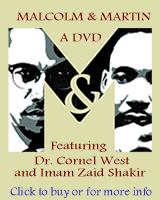 |
 |
 |
| |
| |






















